 |
Polemics

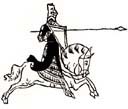 |  | Will John Paul II Return the Icon of Kazan
to an Unconverted Russia? | 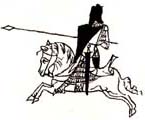 |
Marian T. Horvat, Ph.D
Rumors were again circulating this spring that John Paul II was planning a stopover trip to Russia in August on his way home from Mongolia to give the miraculous Icon of Our Lady of Kazan to Russian “Orthodox” patriarch Alexis II. The latest news release reports that the Moscow patriarchate once again has spurned the Pope’s attempt to visit, despite the fact he holds the sacred national icon as his calling card. (1)
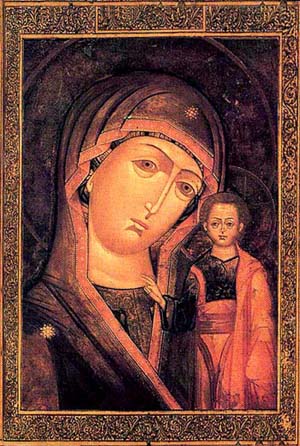
The sacred icon of Our Lady of Kazan
|
It is well known that a high item on this Pontiff’s ecumenical agenda is a visit to Russia. On various pretexts John Paul II has often “asked permission” to stop his plane in Russia, but consent has been obstinately and unceremoniously denied by the schismatic religious authorities.
Yes, Alexis II does want back the symbolic Russian icon, and plans to have it. But no thank you to the Pope’s ecumenical efforts, he does not want the Roman Pontiff to deliver it.
1. Symbolism of the Kazan Icon
The Icon of Kazan has a great symbolic value in both the East and the West. There are several versions of the history of how the original Kazan icon, said to date from the 13th century, arrived in Russia. (2) The devotion spread rapidly and came to be connected with the destiny of Russia as a nation. Carried by generals into battles, the Kazan icon – known in Russia as the Kazanskaya, the “Protection of Russia” – became the symbol of Russian victory and liberty. Under this invocation Our Lady became the patroness of households in Russian families. Millions of reproductions of the icon, many covered with gold, silver and precious stones, testify to the great veneration of Russians for the icon.
For the West there is also a great symbolism The miraculous Icon disappeared from the Basilica of Our Lady of Kazan in Moscow shortly after the Bolsheviks came to power in 1918. After stops in several countries, the icon was purchased around 1970 by the Blue Army of Our Lady of Fatima for $3 million. (3) The purchase was made for a very noble purpose: when Russia would convert, as Our Lady foretold at Fatima, the Blue Army would return the Sacred Icon to the country. It would be a first gesture to signify the establishment of the reign of the Immaculate Heart of Mary, also prophesized by Our Lady in 1917.
2. Kazan and the Fatima message
The Blue Army built a small chapel in Fatima for the icon’s safekeeping, and it remained there until 1993, when it was given to John Paul II, who transferred it to his private apartments in Rome and announced his intention to hand-deliver it to Russia as soon as possible. That is to say, the icon would be returned to Russia based on the false notion that Russia had converted and the promises of Fatima were fulfilled. (4)
Thus, the return of the Kazanskaya to the Schismatic patriarch Alexis II would signify that Russia does not need conversion and that the Russian Schismatic Church is not in error. Instead of being a confirmation of the conversion of Russia, as it was initially planned, this return would close the door on the realization of the Fatima message. It would signify that Fatima no longer has relevance for our times.
An important part of the Fatima message, one that the present day Vatican seems determined to discount or revise at all account, are the words of the Virgin Mary about Russia. In her July 13 appearance to the three children, Our Lady said she would come to ask “for the consecration of Russia to My Immaculate Heart and the Communion of Reparation of the first Saturdays. If my requests are listened to, Russia will be converted and there will be peace… If not, she will spread her errors throughout the world.”
She came again to Lucy at Tuy in 1929, where she asked specifically for the consecration of Russia by the Holy Father together with all the Bishops of the world to her Immaculate Heart.
The requested consecration has not been made
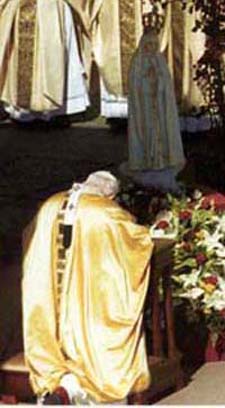
October 2000 - JP II "entrusting" the world to the Immaculate Heart...
Inside the Vatican, November 2000 |
This message was faithfully transmitted to Pope Pius XI, who did not heed Our Lady’s words. The world witnessed the consequent lightning expansion of Communism. The consecration as specified by Our Lady has not been made by the consequent Popes, although certain variations on the theme have been made, eight times in fact: three times by Pius XII, once by Paul VI, and four times by John Paul II. (5)
The ensemble of these attempts reveals an insecurity. If the first was the consecration that Our Lady asked for, why make the second? Why the third and the fourth? The patch-up has continued right up to the eighth, John Paul II’s “entrustment” of the world to the Immaculate Heart in 2000.
Notwithstanding this continuous mending process, the Vatican has insisted that the consecration was carried out, albeit not exactly as Our Lady asked.
This statement is clearly open to discussion. Many authors, including myself, do not agree with this interpretation. If the Queen of Heaven set out certain conditions in clear-cut terms for the conversion of Russia, it does not seem possible to do anything but what she specified. Not one of the eight incomplete variations carries out her orders.
The good fruits are not present
The good fruits promised by Our Lady after a valid consecration are also missing. Instead, we see that:
• The so-called Orthodox Russian Church continues steadfast in the same errors and heresies denounced by St. Pius X in his letter Ex quo of December 26, 1910. The Russian people did not reject the “Orthodox” church, therefore Russia has not converted.
• Communism has not died. It continues to exist with the same face in many countries - China, Vietnam, North Korea, Cuba, etc - and with a different face in countries of Eastern Europe, namely in Russia, itself.
• The world is not living, quite obviously, in the promised time of piety and peace that would follow Russia’s conversion.
In view of these facts, how would John Paul II justify his intention to return the Icon of Kazan to an unconverted Russia? For it is clear that is what he wants to do.
A twisted interpretation of conversion
A new twisted understanding of the word conversion has been put forward to avoid offending the always resentful and invariably arrogant Schismatic Church. This new version aims to weld together contradictory positions – the conversion of Russia and the ecumenical goals of this Pope.

June 26, 2000
Bertone and Ratzinger: "the events to which the third part of the secret of Fatima refers now seem part of the past"
Inside the Vatican, Special Supplement June-July 2000
 |
According to it, Russia’s conversion should not be considered in the “narrow Catholic interpretation,” that is, the rejection of the Schism and a return to Catholicism. Paradoxically, “conversion” would mean that Russia could remain in the errors of the Schismatic Church. This new “interpretation” is a shameless invitation for Catholics to swallow the blatant contradiction. (6)
Further, according to those who have adopted this novel line of thinking, Russia would be experiencing a new springtime of graces after the fall of the Iron Curtain, which would confirm the fulfillment of Fatima message. In fact, this is not the case. Catholic missionaries report a bleak picture of the Post-Communist religious panorama in Russia, whose people have suffered a damaged sense of morals and only 1/10th of 1 percent of the 54 % of Russians who are "orthodox" actually practice their faith. (7)
A Catholic organ that is tirelessly disseminating this contradictory version of conversion and the fulfillment of the Fatima message is the magazine Inside the Vatican. With the latest prospect of the Pope’s visit to Kazan in August to return the icon, editor Robert Moynihan again posed the question about its relationship to Fatima: "Might this restoration of the icon be part of an unfolding process connected with the secret of Fatima … that ‘Russia will be converted?’" (8)
Yes, he hastens to assure us, it does. Certainly Russia is a “converted” country, and “the Russians have never abandoned their Christian faith.” He continues:
“So it would be wrong and demeaning to Russia’s past and present believers and martyrs to say that Russia ‘lost’ the faith and must somehow ‘find it’ again. … So the return now of any Marian icon, but especially an icon universally known and acclaimed in Russia as ‘the Protection of Russia,’ cannot but seem a metaphor of Mary’s ‘return’ – the faith’s return – to Russia. And the return of the faith is another name for conversion.” (9)
Moynihan’s semantic twists and turns are absolutely amazing. Once again, we are expected to believe that the words Our Lady spoke at Fatima were not precise. But they were. She did not say that Russia would remain in the rebellious and heretical position it has held for centuries; she clearly said that Russia would convert, which means a return to the one true fold of Christ.
Moynihan’s acrobatics with doctrinal matters are much more serious than his semantic tricks. He asks us to disregard the schism and the errors professed by the Russian Schismatic Church. That is to say, it continues to deny the dogmas of the Filioque in the Trinitarian procession, the Immaculate Conception of Our Lady, the Petrine Primacy and Papal infallibility. The denial of any one of these dogma is sufficient to transform the schism to heresy. We should also pay no mind to the prior teaching of the Church condemning these errors. (10) With this possibility we leave the arena of the absurd, and enter that of the shameful.
The final offense is to pretend that this conversion is the fulfillment of the promise of Our Lady at Fatima of the consecration and consequent conversion of Russia, with the return of the Icon of Kazan its symbolic confirmation.
3. The urony and the dishonor of the situation
The irony of the matter is that the more John Paul II insists upon handing over the icon, the more the Schismatics want to avoid meeting with him to receive it. There was much talk of a possible return at the end of the Pontiff’s 2002 trip to the Ukraine. The one condition the Vatican placed was that Alexis II or one of his delegates should be there to receive it. Even that small condition was not acceptable. (11)
In response, the Russian schismatic leader offended the Vatican by asking Interpol, the International Policy Agency, to seize the Icon of Kazan from the papal apartments, charging that it had been “stolen” from the Russian Church and should be recovered “by whatever means are necessary.” (12) Yet another aggressive and hostile rejoinder to the repeated subservient requests of John Paul II for reconciliation with the Russian Schismatic Church.
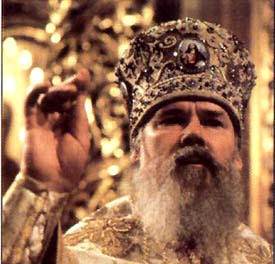
Alexis II arrogantly rebuffs Vatican initiatives to dialogue |
The Vatican has received a veritable litany of insults and rebuffs from the Moscow Patriarchate since its first ecumenical initiatives after the fall of the Iron Curtain. (13) What provoked this aggrieved attitude? The Schismatic patriarchate of Moscow has voiced basically two complaints against the Roman Church: It accuses Rome of proselytism, and it objects to the vigorous activities of the Uniate Roman Catholics in the Ukraine who are asking for their churches to be returned to them - churches which Stalin had formerly handed over to the “orthodox.” These “outstanding problems in Catholic-orthodox” relations, as the patriarch calls them, must be resolved before he will meet with the Pontiff.
This rancorous resentment toward the Holy See continues even to our days despite the innumerable Vatican apologies and concessions. In 1995 John Paul II offered a dramatic apology for grave sins committed in the Church’s name over the course of History, the first mentioned being the “dissolution of Christian unity.”
He has even gone so far as to suggest an openness to “find a way to exercise the [Petrine] Primacy that …. will open to a new situation” (Ut unum sint, 95b). It is a bold and shocking initiative to discuss the undiscussible – the question of the Petrine Primacy.
On May 27, schismatic and Catholic theologians held the first official meeting in Rome to formulate an initial response to JPII’s petition. Noticeably absent from the table were the invited representatives from the Russian “orthodox” patriarchate. (14)
The situation today has become increasingly tense because of new Russian resentments over John Paul II’s decision in February 2002 to create four Dioceses in Russia, even though the action was accompanied by his strong assurances that this was not an attempt to “proselytize.” In retaliation, many measures have been taken. For example, a Catholic Bishop and an Italian priest were expelled from Russia without any explanations by the authorities, their valid Russian visas revoked and re-entry refused. (15)
The Vatican has rushed to appease, reappointing the expelled Russian Bishop to a Polish see in order to “heal at least one of the open problems impeding better relations.” (16) It was obviously not a curative salve. In response to the Vatican’s recent appeal to stop in Kazan to deliver the sacred icon, the patriarchate of Moscow refused permission once again, still complaining about the Catholic dioceses.
It is easy to see the pattern on the road to Kazan. The “orthodox” insist that the problem of Catholic proselytism needs to be solved before a meeting can be held. The Vatican argues a meeting should be held as a first step toward resolving the problems and holds out the coveted Icon of Kazan as a bargaining card to get to the table. The result, a stalemate between an arrogant Patriarchate and a dishonored Vatican.
4. Timely questions
It is difficult to understand why Rome bows and quakes in face of Moscow’s charge of proselytism, which is just a fancy word used since Vatican II to signify the obligatory missionary work of the Catholic Church. Three questions can be asked:
First: What is wrong with proselytism? Why should Catholic missionaries in Russia curb their zeal or lessen their efforts to convert just to forestall “orthodox” complaints and further ecumenical goals? Why should Vatican policy prescribe a diluted missionary effort so as not to offend a schismatic sect?
Second: Why does John Paul II insist on a one-sided ecumenism when the initiative has been so clearly rejected by the other side?
The third question summarizes the topic at hand. What would a return of the Icon of Our Lady of Kazan to an unconverted Russia mean at the present moment? Would it open the doors to a rapprochement between the Catholics and schismatics, as John Paul II seems to expect? It would be a great surprise.
What is certain is that it would deceitfully imply that Russia has converted in fulfillment of the Fatima prophecies. This falsehood promoted by a Pope would clearly provoke the wrath of God and steer us closer to the chastisement that Our Lady warned of. Therefore, regardless of all the efforts to convince us of the contrary, the Fatima message is becoming even more timely and relevant for our times.
1. “Kazan Icon’s Return Doesn’t Justify Papal Visit, Moscow Patriarchate Says,” Zenit News Service, June 20, 2003.
2. John J. Mowatt, The Holy and Miraculous Icon of Our Lady of Kazan (Fatima: Domus Pacis, n.d.).
3. Dimitri Khafizov, “The Modern History of the Sacred Image of Our Lady of Kazan,” Inside the Vatican, February 2002, p. 72.
4. For a full account of the Blue Army’s betrayal of their custodianship, see my article “Handing Over the Symbolic Icon of Our Lady of Kazan: A Confirmation of a Great Crisis in the Church,” The Remnant, January 31, 2001.
5. Pius XII, acting alone, consecrated the world to the Immaculate Heart on October 31 and December 8 of 1942. On July 7, 1952, he consecrated Russia but not in union with all the bishops of the world. Paul VI consecrated the world (without specific mention of Russia) at the closing session of Vatican II. John Paul II consecrated the world (without specific mention of Russia) on June 7, 1981, May 13, 1982, and March 25, 1984. On October 8, 2000 he made an “entrustment” of the world to the Immaculate Heart. Fr. Paul Kramer, The Devil’s Final Battle (Terryville, CT: The Missionary Ass., n.d. ), pp. 263-84.
6. Marguerite Peeters, “The Icon of Our Lady of Kazan,” Lead story, Inside the Vatican, November 2000.
7. M. T. Horvat, "The Myth of a Converted Russia Exposed."
8. “Possible Dream?” Inside the Vatican, April-May 2003, p. 19.
9. Ibid., pp. 18-9.
10. Atila Sinke Guimarães, Quo Vadis, Petre? (Los Angeles: TIA, 1999). “Chapter II - Catholic doctrine and ecumenism.”
11. Zenit News Agency, February 1, 2002.
12. Catholic World News, February 20, 2002.
13. Guimarães lists some principal events of our times that demonstrate the anti-ecumenical position of the Schismatic Church toward the Holy See. Quo Vadis, Petre?, pp. 53-66.
14. “Orthodox and Catholic Theologians Discuss Papal Ministry,” Zenit News Agency, May 27, 2003.
15. "Anti-Catholic Protests in Russia Fail to Draw Big Crowds,” Zenit News Agency, April 29, 2002.
16. Moynihan, “Possible Dream,” p. 16.
Continued

Other Articles in the Polemic
 Handing Over the Symbolic Icon of Our Lady of Kazan Handing Over the Symbolic Icon of Our Lady of Kazan
Dr. Marian T. Horvat.
 Soul Editor Contends The Remnant Slandered Blue Army Soul Editor Contends The Remnant Slandered Blue Army
Letter to the Editor by Fr. Ladis J. Cizik, director of The Blue Army and editor of Soul magazine
 Dr. Horvat Explains Dr. Horvat Explains
Response to Fr. Cizik's letter
 The Myth of a Converted Russia Exposed The Myth of a Converted Russia Exposed
Dr. Marian Horvat
 Kazan, The End of the Story Kazan, The End of the Story
Atila Sinke Guimarães
 A Triple Betrayal of the Catholic Church A Triple Betrayal of the Catholic Church
Dr. Marian Horvat


|
Polemics | Home | News | Books | CDs | Search | Contact Us

© 2002-
Tradition in Action, Inc. All Rights Reserved
|
 |
|
